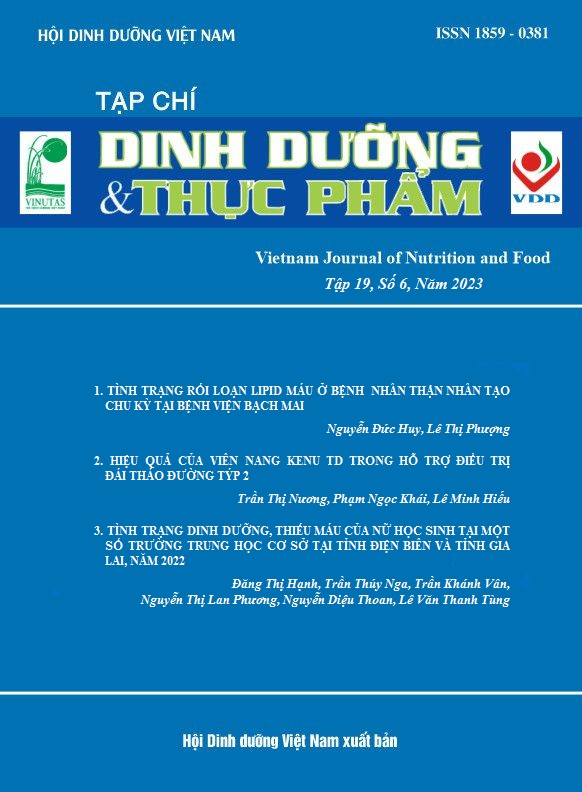STUDY FOR DETAMINATION OF YOUNG LEAF EXTRACTED BIOACTIVES FROM RICE VARIETY HUYET RONG AND APPLICABILITY
Main Article Content
Abstract
Aims: This study aims to analyze the phytochemical compounds, antioxidant and antibacterial activities of the ethanol extract obtained from young rice leaves of Huyet Rong variety.
Methods: Young rice leaf extract powder of Huyet Rong variety was measured for total phenolic content, total flavonoid content and total chlorophyll content, and tested for antioxidant activities in reducing power (RP), 2,2’-azinobis-(3-ethylbenzothiazoline-6-sulfonic acid) (ABTS), and 2,2-diphenyl-1-picrylhydrazyl (DPPH) radical scavenging assays. Agar well diffusion method was used to test antibacterial activity against Staphylococcus aureus and Escherichia coli. The phytochemical compounds in young rice leaf powder were determined by GC-MS.
Results: The extract contained a total of 3.15 ± 0.43 mg GAE/g, 0.86 ± 0.03 mg QE/g, and 1.29 ± 0.11 mg/g of polyphenols, flavonoids, and chlorophyll, respectively. The antioxidant activity of the rice extract was evaluated using DPPH, ABTS, and RP assays, which yielded IC50 values of 344.52 ± 5.22 µg/mL, 789.63 ± 7.56 µg/mL, and 789.63 ± 7.56 µg/mL, respectively. Additionally, the extract exhibited antibacterial effects against both Staphylococcus aureus and Escherichia coli. According to GC-MS analysis, the primary phytochemical compounds present in the extract were 1,2-Benzenedicarboxylic acid, diisooctyl ester (91.75%), followed by phytol (2.25%) and stigmasterol (1.29%).
Conclusion: The young rice leaf extracts could serve as a valuable source of phytochemical compounds that could be utilized as supplements in various functional food applications.
Keywords
Chlorophyll, antioxidants, flavonoids, GC-MS, polyphenols
Article Details
References
2. Khanthapok P, Muangprom A, Sukrong S. Antioxidant activity and DNA protective properties of rice grass juices. ScienceAsia. 2015;41:119.
3. Cory H, Passarelli S, Szeto J, Tamez M, Mattei J. The role of polyphenols in human health and food systems: A mini-review. Frontiers in Nutrition. 2018;5.
4. Martins T, Barros AN, Rosa E, Antunes L. Enhancing health benefits through chlorophylls and chlorophyll-rich agro-food: A Comprehensive Review. Molecules.2023;28:5344.
5. Singh A, Holvoet S, Mercenier A. Dietary polyphenols in the prevention and treatment of allergic diseases. Clinical & Experimental Allergy. 2011;41(10):1346-1359
6. Ebrahimi P, Shokramraji Z, Tavakkoli S, Mihaylova D, Lante A. Chlorophylls as natural bioactive compounds existing in food by-products: A critical review. Plants.2023; 12(7):1533
7. Dziedziński M, Kobus-Cisowska J, Powałowska D, Stuper K, Baranowska M. Polyphenols composition, antioxidant and antimicrobial properties of Pinus sylvestris L. shoots extracts depending on different drying methods. Emirates Journal of Food and Agriculture. 2020;32:229.
8. Chen X, Li H, Zhang B, Deng Z. The synergistic and antagonistic antioxidant interactions of dietary phytochemical combinations. Critical Reviews in Food Science and Nutrition. 2022;62(20):5658-5677.
9. Fiehn O. Metabolomics by gas chromatography-mass spectrometry: Combined targeted and untargeted profiling. Current Protocols in Molecular Biology. 2016;114:31-34.
10. Peixoto Araujo NM, Arruda HS, dos Santos FN, de Morais DR, Pereira GA, Pastore GM. LC-MS/MS screening and identification of bioactive compounds in leaves, pulp and seed from Eugenia calycina Cambess. Food Research International. 2020;137:109556.
11. Choudhury F, Pandey P, Meitei R, Cardona D, Gujar A, Shulaev V. GC-MS/MS profiling of plant metabolites. In Shulaev, V. (eds) Plant Metabolic Engineering. Methods in Molecular Biology, vol 2396. Humana, New York:2022, 101-115.
12. Klopsch R, Baldermann S, Voss A, Rohn S, Schreiner M, Neugart S. Narrow-Banded UVB affects the stability of secondary plant metabolites in kale (Brassica oleracea var. sabellica) and pea (Pisum sativum) leaves being added to lentil flour fortified bread: A novel approach for producing functional foods. Foods.2019;8 (10):427.
13. Djeridane A, Yousfi M, Nadjemi B, Boutassouna D, Stocker P, Vidal N. Antioxidant activity of some algerian medicinal plants extracts containing phenolic compounds. Food Chemistry. 2006;97 (4):654-660.
14. Thepthanee C, Liu C-C, Yu H-S, Huang H-S, Yen C-H, Li Y-H, Lee M-R, Liaw E-T. Antioxidant activity and inhibitory effects of black rice leaf on the proliferation of human carcinoma cells. BioMed Research International. 2022;2022:1-17.
15. Mobeen S, Riazunnisa K. Data on GC-MS analysis, in vitro anti-oxidant and anti-microbial activity of the Catharanthus roseus and Moringa oleiferaleaf extracts. Data in Brief. 2020;29:105258.
16. Bocco R, Gandonou C, Gbaguidi F, Coffi A. Phytochemical screening and quantitative variation of some secondary metabolites in five cultivated rice varieties. Journal of Applied Biosciences.2017;113:11146-11157.
17. Zainal A, Salleh N, Wan Ahmad WAN, Rasudin S, Zaabar W, Ghafar N. Antioxidant properties and antimicrobial effect of zingiber officinale extract towards Escherichia coli, Staphylococcus aureus and Pseudomonas aeruginosa. IOP Conference Series: Earth and Environmental Science. 2022;1102:012049.
18. Jafari Sales A, Nasiri R, Mahmoudi S. In-vitro antibacterial effects of methanolic extract of peppermint (Mentha Piperita Lamiaceae) on standard Staphylococcus aureus, Bacillus cereus, Escherichia coli and Pseudomonas aeruginosa strain. Jorjani Biomedicine Journal. 2019;7:4-10.
19. Elghaffar RYA, Amin BH, Hashem AH, Sehim AE. Promising Endophytic Alternaria alternata from Leaves of Ziziphus spina-christi: Phytochemical Analyses, Antimicrobial and Antioxidant Activities. Applied Biochemistry and Biotechnology. 2022;194 (9):3984-4001.
20. Alonso A-M, Reyes-Maldonado OK, Puebla-Pérez AM, Arreola MP, Velasco-Ramírez SF, Zúñiga-Mayo V, Sánchez-Fernández RE, Delgado-Saucedo J-I, Velázquez-Juárez G. GC/MS analysis, antioxidant activity, and antimicrobial effect of Pelargonium peltatum (Geraniaceae). Molecules.2022; 27:3436.
21. Toh SC, Lihan S, Bunya S, Leong S. In vitro antimicrobial efficacy of Cassia alata (Linn.) leaves, stem, and root extracts against cellulitis causative agent Staphylococcus aureus. BMC Complementary Medicine and Therapies. 2023;23.
22. Mishra V, Tomar S, Yadav P, Vishwakarma S, Singh M. Elemental analysis, phytochemical screening and evaluation of antioxidant, antibacterial and anticancer activity of Pleurotus ostreatus through In Vitro and In Silicoapproaches. Metabolites. 2022;12:821.
23. Thakur M, Singh K, Khedkar R. 11 - Phytochemicals: Extraction process, safety assessment, toxicological evaluations, and regulatory issues. In Functional and Preservative Properties of Phytochemicals, Prakash, B, Ed.; Academic Press: 2020, 341-361.


